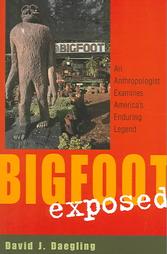Getting an Expert's Take On the Evidence | Finding Bigfoot
Finding Bigfoot Season Three – Ripped from the Headlines
The Idaho episode was filmed towards the end of June in 2012. It was
the last to be filmed of the ten or so episodes for that particular run,
so it’s a little funny that it is the first one to be aired for this
season.
We were actually on the road filming the season when I first heard of
the Mink Creek footage. Brandon Tennant sent me a clip of it after he
and Dr. Jeff Meldrum visited the location to do some on-site
investigation and comparisons. Since the initial investigation by these
two researchers didn’t turn up any signs of the clip being a hoax, we
got the producers on the trail and started the wheels in motion to do an
Idaho episode.
The young men who filmed the Mink Creek footage were in high school
at the time, but had now graduated and were moving on with their lives.
When the footage was obtained, they were in the area doing erosion
studies for one of the science classes. While walking across a hillside,
one of them noticed a dark figure contrasting against the snowy
background on the opposite side of the valley. After taking a few looks
at the figure and agreeing that it looked very unusual, they got out a
video camera and started recording it just before they lost sight of it.

The trail head at the film site’s location
After filming the figure, the witnesses made their way up to the
location where the creature was seen walking. They had some difficulty
getting up there through the thick brush and sometimes-knee-deep snow.
Upon arrival, they found where the creature had walked and photographed
one footprint left in the snow. Having this piece of corroborating
evidence was very important for this case.
I initially had some reservations about the footprint. It looked a
little funky to me, and some of the contours of the foot caused some
concern. After later visiting Dr. Meldrum and discussing the print, he
put my concerns to rest by showing me examples from his extensive cast
collection that mirrored some of the morphology of the Mink Creek print.
I am much more willing to accept the print as authentic now than I was
before.

The only photo of a footprint from the film site
Knowing that films and recordings never truly show what can be seen
and heard with our senses, I asked the young men to describe what they
saw with their own eyes. The saw the figure far to the left of where the
film shows it, and it was walking through the treed area towards the
thick brush. They reported that it looked very massive, and they saw no
signs of clothing or skin. If this was a person who was dressed in heavy
winter clothing, it was all of one color, and no skin was showing
anywhere.
The distance from the camera to the film subject was measured at the
location to be 170 yards. I believe we positioned Ranae very close to
where the figure is seen to be walking in the film. The witnesses
laughed at how small Ranae looked compared the figure.

Ranae and a producer at the location of the film subject
I came into this investigation thinking that this could very well be a
case of hoaxing by teenagers, especially with the concerns I had with
the footprint photograph. However, after speaking with the witnesses, I
am pretty convinced that they are not lying about what happened that
day. They proved themselves to be people of religious morality and
intelligence with future aspirations that mirror this. In fact, their
wish to remain anonymous is partly due to their concern about sports
scholarships and pending acceptance to universities. At worst, this
might be a case of a misidentification, but I think it’s very likely
that they filmed a bigfoot.
The town hall meeting was pretty interesting. Dr. Meldrum attended
with a couple of his sons. There was a botonist that saw a large
sasquatch many miles back in a wilderness area. Another man had
photographed footprints just the weekend before in an area of frequent
bigfoot activity, which is where Ranae went for her solo camping
excursion. Many Native Americans from the local Fort Hall Reservation
came out to hear stories of bigfoots from the area, but almost none of
them shared encounters… until after the meeting ended. We were then
overwhelmed with both the number and quality of sightings from the local
Indians. As is often the case, they just didn’t want to share their
encounters on camera out of respect for the sasquatches.
The Idaho expedition was one of the first times I really was taken by
surprise as to where bigfoots hang out. While the mountains surrounding
Pocatello, ID are typical bigfoot habitat, the flat lands look like
about the last place a bigfoot would want to hang out. Yet, there are
very credible sightings from these flat, largely-treeless areas. These
sightings usually happen in farm lands that are not far from waterways.
Some of the reporting witnesses are law enforcement officers who have
seen the sasquatches both with their eyes and with thermal imagers. Once
again, bigfoots do some very unexpected things in some very unexpected
locations. They are full of surprises, to say the very least.
One of the highlights of this episode was a visit to Dr. Jeff
Meldrum’s laboratory at Idaho State University. He is such a huge source
of knowledge, not only in his chosen field of expertise (anatomy), but
also in the ecology and biodiversity of the surrounding wild areas. Upon
his investigation of the Mink Creek footage, he noted that just above
where the creature was filmed was an extensive field of Hawthorn
berries. Hawthorn berries fruit during the cold winter months, and are
high in antioxidants. Bears in the area often eat tons of hawthorn
berries before they enter hibernation or torpor (a level of very low
activity) during the winter to allow the antioxidants to clean their
systems. Perhaps this is what the bigfoot was doing up on that hill at
that time? Dr. Meldrum also told us of the field work he has done in the
surrounding mountains at various times of year, and recommended a
specific area where we might have some luck with our last night
investigation.

Producer and “show runner,” Chad Hammel with Dr. Jeff
Meldrum in his laboratory at Idaho State University
Bobo’s idea for our last night investigation’s search technique of
holding a rave in the woods may sound ridiculous and uniquely “Bobo” in
character, but I agree with him that this sort of thing could work.
While I’m not, nor have ever been, a raver of any sort, I do know that
the kids that hang out in the woods and party outside of Estacada,
Sandy, and Molalla in Oregon often report strange things in the woods
nearby their loud parties. Adding some lasers, a light show, and some
interesting noises just might make our presence irresistable for a
curious bigfoot to come check out. Besides, Bobo is pretty strong in the
Force, and he has a strange sense of luck surrounding him. Additinoally
his ideas, though kind of nutty on the surface, are usually grounded in
some past experience. One thing for sure is that his ideas are always
fun.
That night, Bobo filmed something in a tree just 150 yards below his
and Matt’s position. That thing was reported to be perhaps two-thirds of
my size. For some reason, the other team told Ranae and I to move to
the location to check it out, which we were more than happy to do. When
we got there, we found that Bobo and Matt could have easily moved down
slope a bit to see it for themselves, rather than having Ranae and I
move down crumbly ledges, through thorny thickets, and bushwalk almost a
third of a mile to the location.
When we were at the site, I climbed the tree and Bobo described the
differences between what he saw and how I looked in the same thermal. I
thought at the time that it was possible that he filmed a bigfoot, but
most likely some other mammal such as a bear or porcupine. Now that I
have seen the footage, I am much more certain that he most likely filmed
one of the latter species and not a bigfoot at all. Still, if it was a
bear then neither Bobo nor Matt saw it leave the area. If it was a
porcupine, I never saw it near or in the tree. I don’t know what Bobo
filmed, but I tend to think it was a more common animal and not a
bigfoot. We will never know.
Idaho was an eye-opening experience for me. The witnesses described
pretty typical bigfoot encounters, but the terrain was so different than
what I was used to down on the flat lands. The visit with Dr. Meldrum
was definitely a high point, and in fact we had lunch the next day to
further discuss the London trackway and other bigfooty things. It was a
great end of a long run of filming episodes, having been on the road
since the end of February at the time. I also think this episode is a
strong opener for the brand new season of Finding Bigfoot.
Enjoy these photos from the trip:

This
rural farm was repeatedly visited by more than one bigfoot. It hardly
appears to be typical bigfoot habitat, but there is a canal nearby, and
the witnesses seem to be honest people.

Once you gain a little elevation, the habitat becomes lush and perfect for the big guys.

The actual camera used to film the Mink Creek footage

















 Commentary:
Commentary: